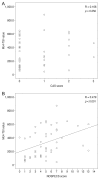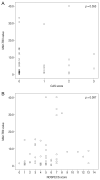Clinical Association of Thyroid Stimulating Hormone Receptor Antibody Levels with Disease Severity in the Chronic Inactive Stage of Graves' Orbitopathy
- PMID: 26240504
- PMCID: PMC4520863
- DOI: 10.3341/kjo.2015.29.4.213
Clinical Association of Thyroid Stimulating Hormone Receptor Antibody Levels with Disease Severity in the Chronic Inactive Stage of Graves' Orbitopathy
Abstract
Purpose: To investigate associations between serum thyroid stimulating hormone (TSH) receptor antibody (TRAb) levels and Graves' orbitopathy (GO) activity/severity in chronic-stage GO and compare the performance of two newly-developed TRAb assays (third-generation TSH-binding inhibition immunoglobulin [TBII] assay versus Mc4 thyroid-stimulating immunoglobulin [TSI] bioassay).
Methods: This study is a retrospective review of medical charts and blood tests from Korean GO patients who first visited the departments of ophthalmology and endocrinology, Yonsei University College of Medicine from January 2008 to December 2011, were diagnosed with GO and Graves' hyperthyroidism, and were followed up for ≥18 months. Third-generation M22-TBII and Mc4-TSI assays were performed in the chronic-inactive GO patients in whom euthyroidism status was restored. Patients' GO activity/severity clinical activity scores (CAS), and modified NOSPECS scores were examined for a correlation with TRAb assays.
Results: Fifty patients (mean age, 41.3 years; 41 females) were analyzed. The mean duration of Graves' hyperthyroidism symptom was 63 months (range, 18 to 401 months) and that of GO was 46 months (range, 18 to 240 months). All patients had been treated previously with anti-thyroid drugs for a median period of 52.3 months, and two patients underwent either radioiodine therapy or total thyroidectomy. Mean CAS and NOSPECS scores were 0.5 ± 0.9 (standard deviation) and 4.8 ± 3.1, respectively. Mean M22-TBII and Mc4-TSI values were 7.5 ± 10.2 IL/L and 325.9 ± 210.1 specimen-to-reference control ratio. TSI was significantly correlated with NOSPECS score (R = 0.479, p < 0.001); however, TBII was not associated with NOSPECS score (p = 0.097). Neither TSI nor TBII correlated with CAS (p > 0.05), because GO inflammatory activity subsided in the chronic stages of GO.
Conclusions: In chronic-inactive GO after euthyroid restoration, GO activity score did not associate with serum levels of TRAb or TBII. However, levels of the functional antibody Mc4-TSI did correlate with GO severity. Therefore, the TSI bioassay is a clinically relevant measure of disease severity even in chronic inactive GO.
Keywords: Biological assay; Chronic inactive Graves' orbitopathy; Mc4-TSI; Thyroid-stimulating immunoglobulin; Thyrotropin-binding inhibitory immunoglobulin.
Conflict of interest statement
Figures


Similar articles
-
Correlation between TSH receptor antibody assays and clinical manifestations of Graves' orbitopathy.Yonsei Med J. 2013 Jul;54(4):1033-9. doi: 10.3349/ymj.2013.54.4.1033. Yonsei Med J. 2013. PMID: 23709442 Free PMC article.
-
Relevance of TSH-receptor antibody levels in predicting disease course in Graves' orbitopathy: comparison of the third-generation TBII assay and Mc4-TSI bioassay.Eye (Lond). 2013 Aug;27(8):964-71. doi: 10.1038/eye.2013.120. Epub 2013 Jun 7. Eye (Lond). 2013. PMID: 23743527 Free PMC article.
-
Clinical results of anti-inflammatory therapy in Graves' ophthalmopathy and association with thyroidal autoantibodies.Clin Endocrinol (Oxf). 2004 Nov;61(5):612-8. doi: 10.1111/j.1365-2265.2004.02143.x. Clin Endocrinol (Oxf). 2004. PMID: 15521965
-
Usefulness of TSH receptor antibodies as biomarkers for Graves' ophthalmopathy: a systematic review.J Endocrinol Invest. 2018 Dec;41(12):1457-1468. doi: 10.1007/s40618-018-0945-6. Epub 2018 Sep 7. J Endocrinol Invest. 2018. PMID: 30194634
-
Clinical value of TSH receptor antibodies measurement in patients with Graves' orbitopathy.Pediatr Endocrinol Rev. 2010 Mar;7 Suppl 2:198-203. Pediatr Endocrinol Rev. 2010. PMID: 20467363 Review.
Cited by
-
Association of clinical course with thyroid-stimulating immunoglobulin in Graves' ophthalmopathy in Mongolians.PLoS One. 2022 Nov 17;17(11):e0277055. doi: 10.1371/journal.pone.0277055. eCollection 2022. PLoS One. 2022. PMID: 36395261 Free PMC article.
-
Teprotumumab Divergently Alters Fibrocyte Gene Expression: Implications for Thyroid-associated Ophthalmopathy.J Clin Endocrinol Metab. 2022 Sep 28;107(10):e4037-e4047. doi: 10.1210/clinem/dgac415. J Clin Endocrinol Metab. 2022. PMID: 35809263 Free PMC article.
-
New advances in understanding thyroid-associated ophthalmopathy and the potential role for insulin-like growth factor-I receptor.F1000Res. 2018 Feb 1;7:134. doi: 10.12688/f1000research.12787.1. eCollection 2018. F1000Res. 2018. PMID: 29744034 Free PMC article. Review.
-
Thyroid Autoimmunity: Role of Anti-thyroid Antibodies in Thyroid and Extra-Thyroidal Diseases.Front Immunol. 2017 May 9;8:521. doi: 10.3389/fimmu.2017.00521. eCollection 2017. Front Immunol. 2017. PMID: 28536577 Free PMC article. Review.
-
Longitudinal association of thyroid-stimulating immunoglobulin levels with clinical characteristics in thyroid eye disease.BMJ Open. 2022 Jun 21;12(6):e050337. doi: 10.1136/bmjopen-2021-050337. BMJ Open. 2022. PMID: 35728893 Free PMC article.
References
-
- Hales IB, Rundle FF. Ocular changes in Graves' disease: a long-term follow-up study. Q J Med. 1960;29:113–126. - PubMed
-
- Eckstein AK, Plicht M, Lax H, et al. Clinical results of anti-inflammatory therapy in Graves' ophthalmopathy and association with thyroidal autoantibodies. Clin Endocrinol (Oxf) 2004;61:612–618. - PubMed
-
- Sanders J, Evans M, Premawardhana LD, et al. Human monoclonal thyroid stimulating autoantibody. Lancet. 2003;362:126–128. - PubMed
-
- Sanders J, Jeffreys J, Depraetere H, et al. Characteristics of a human monoclonal autoantibody to the thyrotropin receptor: sequence structure and function. Thyroid. 2004;14:560–570. - PubMed
Publication types
MeSH terms
Substances
LinkOut - more resources
Full Text Sources
Other Literature Sources

